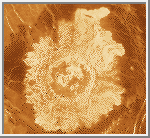
Science-fiction yesterday, fact today- obsolete tomorrow.
- Otto O. Binder
Table of Contents
Impact craters are a common feature on most planetary bodies because projectiles (such as meteoroids, asteroids, and comets) have collided with planetary surfaces for billions of years. Projectiles able to penetrate a planet's atmosphere impact the surface at a velocity of tens of kilometers per second with enough energy to generate shock waves in the crustal rocks. These shock waves propagate to produce craters by the ejection of vapors, melted rocks, hot particles and fragments, sheared and fractured rocks, and large blocks [Melosh, 1989]. During this process, the deepest target material is exposed closest to the crater rim and the most shallow material is deposited farthest from the rim. Generally, impact craters have a circular outline, a raised rim, and a depth that is shallow relative to the diameter. The crater is surrounded by ejecta deposits that decrease in thickness outward from the crater rim. Because of the dense Venusian atmosphere, some aspects of crater formation and morphology on Venus are different from those on other bodies.
There is a general progression in morphology between large, intermediate, and small craters: large craters might have several rings and smooth floors; intermediate craters tend to have a central peak and smooth floors; small craters have a simple bowl floor that is rough. Impact craters exhibit a wide range of degradation on different planets, so they are useful indicators of resurfacing and modification of surfaces. On Earth, craters are rapidly degraded and destroyed by surficial weathering processes. In contrast, Venusian craters remain pristine because they are young, and there is very little weathering that affects them.
General Characteristics
Impact craters are found to be distributed randomly but uniformly over the surface of Venus. Cratering of the terrestrial planets shows a record of two distinct periods, one from the late period of heavy bombardment and the other from a bombardment of asteroids and comets which occured more recently. Venus shows no record of the heavy bombardment period, indicating that it was resurface about 300 to 500 million years ago. The majority of Venusian craters appears pristine because they were formed after Venus was resurfaced; there has been very little geologic activity and weathering since then to degrade and destroy the craters [Schaber et al., 1992]. Venus has a fewer number of small craters than any other planet. Small projectiles vaporize or break up in the Venusian atmosphere before they reach the surface. Many craters display radar-bright or -dark halos, and a number of craters have extended deposits that are parabolically shaped and open to the west [Campbell et al., 1992]. A feature unique to Venusian craters is radar-bright outflow deposits that extend over great distances, following the local topography [Asimow and Wood, 1992].
Impact origin of craters is determined from a group of criteria. The features that best determine an impact origin for a crater are: (1) a circular rim crest outline; (2) flanks that gently rise above the surrounding terrain; (3) floors with elevations lower than those of the surrounding terrain; (4) an ejecta blanket surrounding the crater; and (5) an inner basin that might be present in very large craters. The Venusian impact crater Danilova is 48 kilometers (30 miles) in diameter. It has a central peak, a crater wall, a crater floor, an ejecta blanket, and crater outflow deposits. (See also the geological sketch map for the crater.)
The ejecta blanket and the circular rim of a crater are very bright in radar images because both are rough, with many facets oriented perpendicular to the radar illumination. Typically, the crater wall that slopes toward the radar appears compressed while the wall that slopes away from the radar appears expanded. Walls parallel to the illumination have intermediate brightness and widths.
The symmetry of a crater depends on the angle of impact of the projectile that formed it. Craters produced by an impact that is normal to the surface tend to be radially symmetric: rim crests have roughly equal elevations everywhere and are concentric with the crater floor outline, while flanks appear the same in all radial directions. However, most impact craters are produced by projectiles with trajectories that are oblique to the surface. When the angle is very oblique, the crater has a bilateral symmetry about the plane of the trajectory, with rim crests highest on the down-trajectory side and lowest on the up-trajectory side, while crater flanks extend to distances greater on the down-trajectory sides than on the up-trajectory sides.
Venusian impact craters have either a radar-bright or -dark crater floor, or both. The brightness of the crater floor in Magellan images appears to depend on the incidence angle of the radar, the size of the crater, the terrain on which the crater formed, and the amount of infilling by lava or impact melt.
Impact Crater Classification
Schaber et al. [1992] have classified the Venusian impact craters seen in Magellan images into six morphologic types.
- Multi-ringed craters. These are similar to the larger multiringed basins on the Moon, Mercury, and Mars. The type includes all craters larger than 100 kilometers (60 miles) in diameter.
- Double-ring craters. These have an outer rim and an inner ring. Most craters with diameters larger than 40 kilometers (25 miles) are in this classification.
- Central peak craters. These craters account for approximately 37% of the craters on Venus; they have central mounds or a radar-bright jagged central peak.
- Craters with structureless floors. They generally have terraced walls and flat floors.
- Irregular craters. This type represents the smallest craters of less than 16 kilometers (10 miles) in diameter. Their floors are usually radar bright because they are rough and complex.
- Multiple craters. They are characterized by two or more craters produced by projectiles that impacted very close to each other; in some cases, the crater rims may overlap.
Small, simple bowl-shaped craters, which are quite common on the Moon and Mars, are scarce on Venus. Instead, small Venusian craters form tight clusters and they overlap.
Distinguishing Impact Craters from Volcanic Craters
The Venera 15/16 and Arecibo images of Venus reveal several circular features that resemble both impact craters and volcanic features. Cleopatra, 105 kilometers (65 miles) in diameter and lying on Maxwell Montes, is one of these controversial features. Cleopatra was originally interpreted as a caldera on top of a giant volcanic construct [Masursky et al., 1980]. From the Venera 15/16 and Arecibo images, Basilevsky and Ivanov [1990] interpreted Cleopatra to be a peak-ring structure, which supported an impact origin for the crater. However, the lack of evidence for crater-rim deposits, the large depth of Cleopatra, and extensive plains deposits to the east that apparently emanated from the crater led Schaber et al. [1986] to suggest a possible volcanic origin.
Scientists used Magellan's high-resolution images to solve the mystery of Cleopatra crater. These images show an inner basin, an outer basin, and rough ejecta deposits. Although the crater rim resembles that of a volcanic caldera, the ejecta and the inner basin provide compelling evidence that the structure is an impact crater. The ejecta deposits surrounding Cleopatra appear to be incomplete and do not extend as far as they should for a crater of this size, possibly because the crater was produced on the highlands rather than the plains. The ejecta can be identified as such because they are rougher and have more large-scale slopes than those of the surrounding terrain.
Flows of impact melt or lavas of impact-triggered volcanism breached the crater rim and filled the troughs in the upper-right corner of the image. These flows and the floor of the crater are radar-dark because they are smoother than the surrounding terrain.
Large Crater (Meade) Properties
Mead crater, with a diameter of 280 kilometers (174 miles), is the largest impact crater on Venus. The inner ring is thought to represent the original rim of the crater cavity, while the outer scarp is thought to be the expression of a ring fault that has downdropped the flank terrace [Schaber et al., 1992]. The surrounding plain is covered by fine debris that decreases the return to the radar, and appears darker on the image. The floor of the crater has several large cracks that show as bright lines. Ejecta from the crater that appear as diffuse patches surrounding the crater rim are brighter than the surrounding plain because they are rougher and have more slopes facing the radar. The drop in elevation from the crater rim to the center of the crater is approximately 1.0 kilometer (.6 miles). This is quite shallow for a crater the size of Mead; it may be that Mead has experienced relaxation of its floor, or a large amount of material has flooded the crater floor.
Halos, Outflow Deposits, and Splotches
Yablochkina crater exhibits several interesting features: a radar-dark halo and radar-bright outflow deposits. The crater and its ejecta are surrounded by a dark halo. Approximately half of the impact craters on Venus are partially or wholly surrounded by halos [Phillips et al., 1991]. These halos possibly represent smooth areas with little surface roughness. Atmospheric shock waves produced as the meteoroid passed through the thick atmosphere might have removed wavelength-size structures from the existing terrain and pulverized the surface materials to produce these dark margins. Alternatively, fine debris produced by the destruction of the target material or the meteoroid as it passed through the atmosphere and exploded at the surface might have been deposited before the crater formed. In addition to dark halos, many Venusian craters have bright halos, also thought to have formed from atmospheric shock waves.
Also surrounding the Yablochkina crater in many locations, but particularly to the northeast, are deposits or flows that are often brighter than the crater ejecta. These flows originate predominantly downrange from the point of the impact. The great distances that these deposits travel and the fact that they follow the topography suggest that they consist of low viscosity material [Schaber et al, 1992].
Smaller impactors might be broken up as they enter the Venusian atmosphere [Basilevsky et al., 1987]. Except for the smallest members of some crater clusters, no craters smaller than 3 kilometers (1.9 miles) in diameter have been observed [Phillips et al., 1991]. The image "Crater Cluster" shows an irregular crater of approximately 14 kilometer (8.7 mile) mean diameter. The crater is actually a cluster of four separate craters in rim contact. The noncircular rims and multiple, hummocky floors are probably the result of the breakup and dispersion of a meteoroid during its passage through the dense Venusian atmosphere; subsequently, the meteoroid fragments impacted simultaneously to create the cluster. Meteoroids that would form craters smaller than the observed cutoff diameter of 3 kilometers (1.9 miles) either are not able to penetrate the atmospheric column or they decelerate to velocities insufficient to form impact craters [Phillips et al., 1991]. However, the shock or pressure wave created as such a meteoroid travels through the atmosphere may still have energy sufficient to deform the surface.
The image "Dark Splotches on Lava Flows" shows three dark splotches on the plains of Venus. The impact crater in the splotch at the right indicates that the meteoroid was not completely destroyed and reached the surface to produce a crater. Much of the meteoroid, however, was destroyed and its remnants and/or shock wave produced the large dark margin that surrounds the crater. The other two splotches, at near center and the extreme left, have no associated impact crater, indicating that only a shock wave disturbed the surface. Evidence that these splotches represent a deposit of material is the change in brightness of the underlying lava flows from the center of the splotches outward. The dark margin to the left has associated wind streaks, suggesting that the splotch is composed of material fine enough to be moved by the wind.
Crater Modification
The majority of impact craters on Venus (62%) are pristine and unmodified [Schaber et al., 1992]. This indicates that impact craters have not been significantly altered by surficial processes. In only a few cases have craters been modified by lava flows or tectonism. One example is crater Somerville, a 37 kilometer (23 mile) diameter crater in Beta Regio, which has been cut by many fractures and faults. The crater was split in half during the formation of a rift that is up to 20 kilometers (12.4 miles) wide and apparently quite deep. A north-south profile through the center of this crater is visible as a result of the downdropping. Most of the central peak is visible as a bright spot in the middle of the crater. A radar-bright ejecta blanket is also visible through the fractures. A small portion of the eastern half of the crater can be seen on the far side of the rift. While the majority of large impact craters on Venus have floors that are radar-dark (probably due to flooding of the crater floor by lavas from below after the crater was produced), craters that have been modified by volcanism not associated with the impact process are rare on Venus.
One such rarity is Alcott, a 63 kilometer (39 mile) diameter crater extensively flooded by lava. A remnant of rough, radar-bright radial ejecta is preserved outside the crater's southeast rim. The large, trough-like depression to the southwest is a rille or channel through which lava once flowed; the radar-bright eastern side and radar-dark western side indicate that this feature is a trough with steep slopes. The presence of partly lava-flooded craters like this one is important in understanding the rate of resurfacing on Venus by volcanism. The lack of flooded craters suggests that the surface might have been covered by lava flows about 500 million years ago, burying all existing craters [Schaber et al., 1992]. According to this model, the craters now visible in the Magellan images represent impacts that occurred after this resurfacing event, and there has been very little volcanic and other resurfacing since that time.
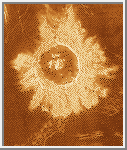
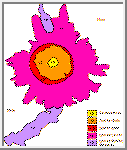 Danilova Crater
Danilova Crater
-26.4° Latitude, 337.2° Longitude; 49 kilometers (30 miles) diameter; central peak crater
The first image shows the Venusian impact crater Danilova as seen by the
Magellan spacecraft. The crater has a central peak, a crater wall, a
crater floor, an ejecta blanket, and crater outflow deposits. The second
image is a geologic sketch map of the crater.
(Copyright Calvin J. Hamilton)
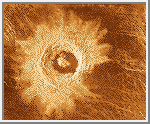 Golubkina Crater
Golubkina Crater
60.30° Latitude, 286.55° Longitude; 30.1 kilometer (19 mile) diameter; central peak crater
This is a Magellan image of Crater Golubkina. The 30.1 kilometer (19 mile)
diameter crater is characterized by terraced inner walls and a
central peak,
typical of large impact craters on the Earth, the Moon and Mars.
The terraced inner walls take shape late in the formation of an impact
crater, due to the collapse of the initial cavity created by the meteorite
impact. The central peak forms due to the rebound of the inner crater
floor. This crater is named after the Russian sculptor Anna Golubkina.
(Copyright Calvin J. Hamilton)
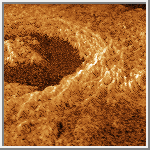 Golubkina in 3D
Golubkina in 3D
This is a computer generated, 3D perspective view of the Golubkina crater.
(Courtesy NASA/JPL)
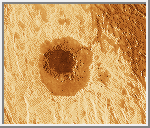 Cleopatra Crater
Cleopatra Crater
65.90° Latitude, 7.00° Longitude; 105 kilometer (65 mile) diameter; double ring crater
Once believed to be a volcanic caldera, Cleopatra was
shown by Magellan data to have an impact origin. A small ejecta blanket
is visible surrounding the crater rim and an inner, radar-dark basin can
be seen on the crater floor. Illumination is from the left at an incidence
angle of 25 degrees.
(Copyright Calvin J. Hamilton)
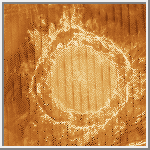 Mead Crater
Mead Crater
12.50° Latitude, 57.20° Longitude; 280 kilometer (174 mile) diameter;
multi-ring crater
Mead crater is the largest impact crater on Venus, with a diameter of 280
kilometers (174 miles). The crater has an inner and an outer ring and a small ejecta blanket
surrounding the outer ring. The crater floor looks very similar in
morphology to the surrounding plain. The dark vertical bands running
through the image are artifacts associated with processing the synthetic aperature radar (SAR) data.
Illumination is from the left at an incidence angle of 45 deg.
(Copyright Calvin J. Hamilton)

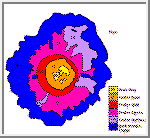 Yablochkina Crater
Yablochkina Crater
48.27° Latitude, 195.15° Longitude; 63 kilometer (39 mile) diameter; double-ring crater
Yablochkina crater exhibits
two interesting features: a radar-dark halo and radar-bright outflow
deposits. The crater and its ejecta are surrounded by a dark halo which
possibly represents smooth areas with little surface roughness.
(Copyright Calvin J. Hamilton)
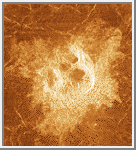 Crater Cluster
Crater Cluster
25.6° Latitude, 336.0° Longitude; 1.5 kilometer (1 mile) diameter; irregular crater
A small projectile broke up in the
atmosphere to form four smaller impactors that struck nearly
simultaneously to form this crater cluster. Illumination is from the left
at an incidence angle of 38 degrees.
(Copyright Calvin J. Hamilton)
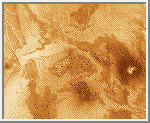 Dark Splotches on Lava Flows
Dark Splotches on Lava Flows
The splotch at far right contains a crater
while the others (at center and far left) do not. The diffuse boundaries of
the splotches and the wind streaks from the splotch at the left indicate
that the splotches are composed of fine debris. Radar illumination is
from the left at an incidence angle of 30 degrees.
(Copyright Calvin J. Hamilton)
 Somerville Crater
Somerville Crater
29.95° Latitude, 282.90° Longitude; 37 kilometer (23 mile) diameter; central peak crater
Somerville crater is split in half by a rift valley. A north-south profile
through the crater is visible in the rift. The eastern half of the crater
is visible on the opposite side of the rift. Illumination is from the left
at an incidence angle of 42 degrees.
(Courtesy Calvin J. Hamilton)
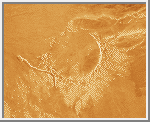 Alcott Crater
Alcott Crater
-59.50° Latitude, 354.55° Longitude; 62.7 kilometer (39 mile) diameter; structureless floor crater
Alcott crater was extensively flooded by lava. A remnant of radar-bright
ejecta is preserved outside the crater's southeast rim. Illumination is
from the left at an incidence angle of 27 degrees.
(Copyright Calvin J. Hamilton)
 Addams Crater
Addams Crater
-56.10° Latitude, 98.90° Longitude; 90 kilometer (56 mile) diameter; double-ring crater
Addams crater is remarkable for the extensive outflow that extends 600 kilometers (373 miles) from the crater rim. Because of the high temperature and pressure on the
Venusian surface, impacts produce more melt than on other planets. Outflow
deposits are very thin. Their direction is controlled by the local
topography.
(Copyright Calvin J. Hamilton)
This article was abstracted from Ford [1993], chapter 7 by Catherine M. Weitz.
Asimow, P. D. and J. A. Wood. "Fluid outflows from Venus impact craters: Analysis from Magellan data." Journal of Geophysical Research, v. 97, p. 13,643-13,665, 1992.
Basilevsky, A. T. and B. A. Ivanov. "Cleopatra crater on Venus: Venera 15/16 data and impact/volcanic origin controversy." Geophysical Research Letters, v. 17, no. 2, p. 175-178, 1990.
Basilevsky, A. T. et al. "Impact craters of Venus: A continuation of the analysis of data from the Venera 15 and 16 spacecraft." Journal of Geophysical Research, v. 92, p. 12,869-12,901, 1987.
Campbell, D. B. et al. "Magellan observations of extended impact crater features on Venus." Journal of Geophysical Research, v. 97, p. 16,249-16,277, 1992.
Ford, John P. et al. Guide to Magellan Image Interpretation. Jet Propulsion Laboratory Publication 93-24, p. 75-92, 1993.
Masursky, H. et al. "Pioneer Venus radar results: Geology from images and altimetry." Journal of Geophysical Research, v. 85, p. 8232-8260, 1980.
Melosh, H. J. Impact Cratering-A Geologic Process. Oxford Monograph Geological Geophysical, no. 11, New York: Oxford University Press, 1989.
Phillips, R. J. et al. "Impact craters and Venus resurfacing history." Journal of Geophysical Research, v. 97, p. 15,923-15,948, 1992.
Schaber, G. G. et al. "Cleopatra crater on Venus: New evidence for a volcanic origin." LPSCXVII, p. 762-763, 1986.
Schaber, G. G. et al. "Geology and distribution of impact craters on Venus: What are they telling us?" Journal of Geophysical Research, v. 97, p. 13,257-13,301, 1992.